- Home
- News & Features
- News
- FY2019
- TOWARD TICAD 7: ‘Africa & Me’ Part 8 - Impoverished Tanzania transformed by “Rice of Hope”: Motonori Tomitaka, former JICA Senior Advisor
News
August 16, 2019
TOWARD TICAD 7: ‘Africa & Me’ Part 8 - Impoverished Tanzania transformed by “Rice of Hope”: Motonori Tomitaka, former JICA Senior Advisor
According to the latest United Nations forecast, the population of sub-Saharan Africa will double from about 1.06 billion in 2019 to about 2.1 billion in 2050*. While this is expected to contribute to economic growth and bigger markets, it raises the urgency of finding solutions to problems such as poverty and food shortages. Among the efforts being made by JICA to promote agricultural development in African countries, a program undertaken in the 1970s to support development of rice cultivation in the Tanzanian foothills of Kilimanjaro, Africa’s highest mountain, has gradually taken on a national scope. The domestic rice (paddy) production, which was approximately 280 thousand tons in the 1970s, grew to over 2.86 million tons in 2016.
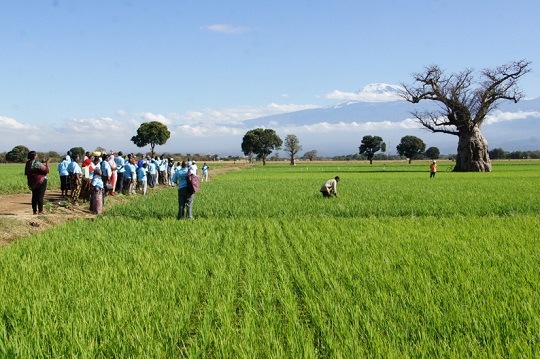 JICA-supported irrigated rice cultivation in the foothills of Kilimanjaro and other areas in northern Tanzania opens the way to development of rice cultivation in Africa.
JICA-supported irrigated rice cultivation in the foothills of Kilimanjaro and other areas in northern Tanzania opens the way to development of rice cultivation in Africa.
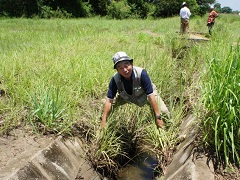 Mr. Motonori Tomitaka, former JICA senior advisor, battling with grass in an irrigation channel
Mr. Motonori Tomitaka, former JICA senior advisor, battling with grass in an irrigation channel
For this 8th installment in the series TOWARD TICAD7: ‘Africa and Me’ Part 8, we interviewed Mr. Motonori Tomitaka, a former JICA senior advisor who worked to promote rice farming in Tanzania for three decades, about the results of long-term cooperation and the changes brought to people’s lives by rice.
*From World Population Prospects 2019 (UN DESA / Population Division)
https://population.un.org/wpp2019/
Famous for coffee production, it was among the poorest countries in Africa
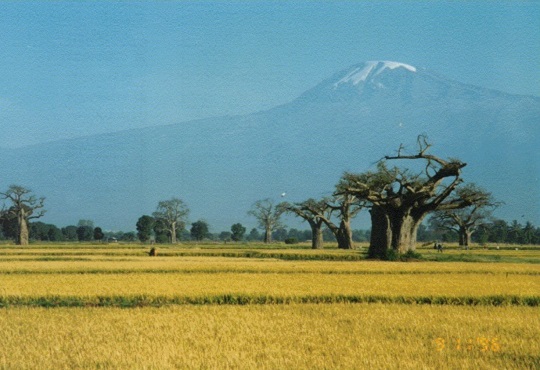 Maturing rice plants in Lower Moshi Irrigation Scheme, Kilimanjaro Region in 1996. Two technical cooperation projects were implemented to support the establishment and stabilization of irrigation farming on farmland developed through the Lower Moshi Agricultural Development Project (a grant aid project completed in 1987): the Kilimanjaro Agricultural Development Center Project (1978-86), and the Kilimanjaro Agricultural Development Project (1986-93).
Maturing rice plants in Lower Moshi Irrigation Scheme, Kilimanjaro Region in 1996. Two technical cooperation projects were implemented to support the establishment and stabilization of irrigation farming on farmland developed through the Lower Moshi Agricultural Development Project (a grant aid project completed in 1987): the Kilimanjaro Agricultural Development Center Project (1978-86), and the Kilimanjaro Agricultural Development Project (1986-93).
Formerly, Tanzania was counted among Africa’s most impoverished countries. The history of JICA’s cooperation on promotion of rice farming in the country goes back to the 1970s.
“While Kilimanjaro Region in Tanzania was known as a coffee and banana producing area, rural life of areas targeted by Japan’s development cooperation could hardly be called prosperous. Housing consisted mostly of hut-like structures with earthen walls and grass roofs, and children ran around barefoot," said Mr. Tomitaka, looking back on the days of his first assignment.
The Tanzanian government requested assistance for development of some Regions to number of countries. Japan was requested to cooperate for development of Kilimanjaro Region.
“JICA supported to formulate the Kilimanjaro Integrated Development Plan. The plan paid attention to the precious runoff from Kilimanjaro’s snowmelt, and included agricultural development with construction of irrigation facilities.”
Mr. Tomitaka became involved with the Kilimanjaro Agricultural Development Project (1986-93) as an expert on upland crops, and with the Kilimanjaro Agricultural Training Center Project (1994-2001) as an expert on rice cultivation.
Change in farmers’ standard of living due to rice cultivation
At first, many farmers were skeptical about irrigated rice cultivation. Rice was thought of as “a crop with little return on labor,” as its cultivation depended on limited precipitation. However, they changed their minds after construction of irrigation facilities, which were completed with Japanese assistance, contributed to the increase of paddy yield (from about 1.5 to 6-7 tons/ha) through a combination of water management, land preparation (puddling and leveling), rice cultivation technologies (improved varieties, fertilizer application, transplanting young seedlings in rows, weeding), etc.
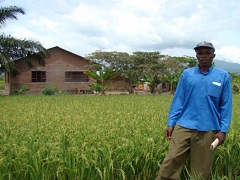 House of an irrigation rice farmer: The introduction of early maturing varieties made it possible to harvest rice two times in a year, leading to great improvements in standard of living. (Meru District, Arusha Region)
House of an irrigation rice farmer: The introduction of early maturing varieties made it possible to harvest rice two times in a year, leading to great improvements in standard of living. (Meru District, Arusha Region)
“Farmers’ dwellings have been replaced with tin-roofed buildings with walls of brick or concrete blocks. Children who previously couldn’t even attend junior high school; now some of them study at high school, technical school and college. There are more clinics, primary and secondary schools in the villages. Irrigated rice cultivation requires many people for planting, weeding, harvesting and so forth, which has also brought increased opportunities for employment.”
As the salability of rice became apparent, technologies of irrigated rice cultivation began to spread to neighboring areas. Later, Mr. Tomitaka was assigned as chief advisor of the Technical Cooperation in Supporting Service Delivery Systems of Irrigated Agriculture (2007-12) and the Project for Supporting Rice Industry Development in Tanzania (2012-19).
Training farmers affected their lives in many ways. “In one happy episode, a farmer who bought a cow with rice income told me that he named its calf ‘Kumbuka Japani’ (Memory of Japan). Before, many farmers sold paddy just after harvesting, but now many of them sell milled rice in off seasons. Women have become more active in society, not only doing housework and helping out on the farm, but jointly managing family finances with their husbands. There have been many sorts of impacts.”
Japanese farmers’ tradition of upkeep takes root in Tanzania
While the support of rice production seemed to be good, when Mr. Tomitaka returned to Tanzania after several years’ absence, he saw unexpected situations in the irrigation canals.
"The concrete channels were covered with grass. The channels do not take care of themselves and will break down if they are not maintained. Achieving sustainable irrigated rice cultivation requires continuous maintenance and management of facilities.”
To deal with this, JICA discussed with relevant organizations and started training for farmers to be more proactive in maintaining and managing irrigation facilities. At that time, Mr. Tomitaka thought back when he was a child growing up in Takachiho, Miyazaki Prefecture, Southern Japan.
“There was an irrigation canal at the back of the house, and in the spring we dug up bamboo shoots that came out beside the channel. We knew that if we let up on maintenance, bamboo roots could break up the channel. Whenever I had the opportunity, I showed photos of my elder brother inspecting the canal and explained that failure to take the initiative in maintenance would lead to their destruction. Recently, I have got the feeling that an awareness of the need to take responsibility for maintenance is taking root among Tanzanian farmers.”
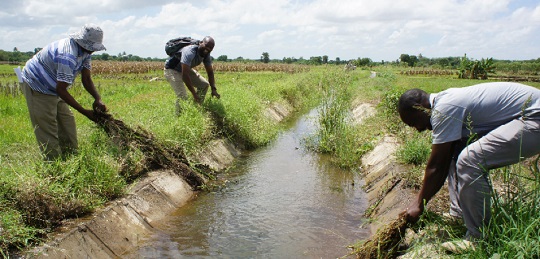 Tanzanian staff cooperating in removal of grass from an irrigation canal (Monduli District, Arusha Region)
Tanzanian staff cooperating in removal of grass from an irrigation canal (Monduli District, Arusha Region)
Returning from Tanzania to Japan at the end of 2018, Mr. Tomitaka expressed his expectations for the next generation as follows.
“Assisting to rice sector development in Africa will contribute not only to improve farmers’ livelihoods, but also to improve food self-sufficiency on the African continent. The lessons learned from Tanzania, including management of irrigation schemes and assessment of gender-related issues, will set valuable precedents for the development of Africa’s rice industry, and support for exchange of extension workers and farmers between neighboring countries should also be effective.”
There is a song that Mr. Tomitaka used to sing while he was in Tanzania. He sang it to the melody of Shiretoko Ryojo (“Shiretoko Love Song,” a song popular in Japan in the 1970s), but with words that he made up himself. The song conveys the depth of his feeling toward the country where he spent many years.
♪When rice plants maturing in foothills of Kilimanjaro, please remember our struggles with passion and sweat for plainlands more productive, profitable and sustainable over years.Any safari in Africa, there is an end at last, we are leaving the places with memories of the white cap, dreams drawn on the maps, beautifully shaped lands, rice culture spreading across the continent.
(Profile)
Motonori Tomitaka
After graduating from university, appointed to the Philippines in 1974 as a member of the Japan Overseas Cooperation Volunteers (on animal husbandry). Appointed as a JICA Senior Advisor from 1985 to 2016. Participated in the Kilimanjaro Agricultural Development Project in 1986. Tomitaka was assigned to the Project for Supporting Rice Industry Development in Tanzania (2015-18), a cooperation project running from November 2012 to December 2019.He was born in Miyazaki.
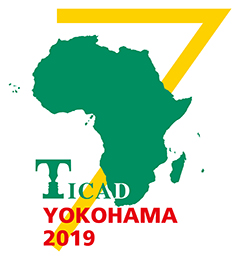
Related Link
- About JICA
- News & Features
- Countries & Regions
- Our Work
- Thematic Issues
- Types of Assistance
- Partnerships with Other Development Partners
- Climate Change / Environmental and Social Considerations
- Evaluations
- Compliance and Anti-corruption
- Science and Technology Cooperation on Global Issues
- Research
- JICA Development Studies Program / JICA Chair
- Support for the Acceptance of Foreign HRs / Multicultural and Inclusive Community
- Publications
- Investor Relations





